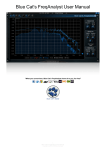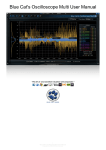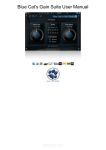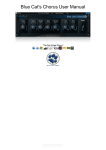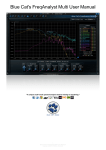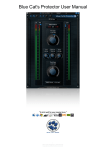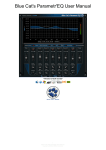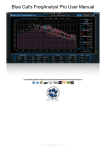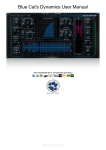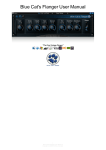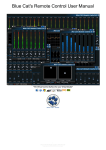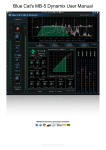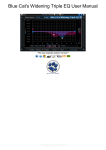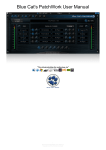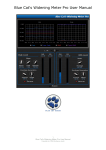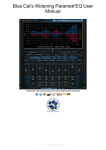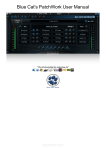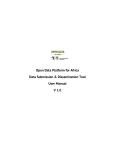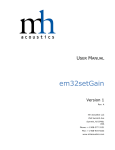Download Blue Cat`s StereoScope Pro User Manual
Transcript
Blue Cat's StereoScope Pro User Manual
"Detailed stereo image analysis with 3D visualization."
1
Blue Cat's StereoScope Pro User Manual
Copyright (c) 2007-2013 Blue Cat Audio
Table Of Content
Introduction
Description
Features
System Requirements
Installation
Using Blue Cat's StereoScope Pro
The User Interface
Operation
Blue Cat Audio Plugins Basics
User Interface Basics
Controls
Keyboard
Mouse
More
Blue Cat's StereoScope Pro Parameters
Input
Output
Blue Cat's StereoScope Pro Curves
Plug- in Settings
The Global Settings Window
The Preset Settings Window
About Skins
Changing the Skin
Create a Custom Skin
Frequently Asked Questions
More
Extra Skins
Tutorials
Updates
Versions History
Note: An online version of this user manual is available here.
2
Blue Cat's StereoScope Pro User Manual
Copyright (c) 2007-2013 Blue Cat Audio
Note: An online version of this user manual is available here.
Introduction
Description
Blue Cat's StereoScope Pro is a real time stereo field analyzer with multiple views and MIDI/ automation output capabilities. It is a
powerful help to analyze how the audio signal is spread in the stereo field, and you can easily detect potential phase and mono
compatibilities issues.
The stereo analysis can be controlled in details, and the precise measurements capabilities combined with the zoomable displays
let you monitor what is exactly happening.
Choose your preferred view for your needs: real time stereo field display, evolution of the stereo image over time (2D or 3D) or
output parameters that explicitly describe the average position and extent of the audio signal in the stereo field. The 3D waterfall
view lets you see in details from your preferred viewpoint the evolution of the stereo image over time.
The four memory slots let you store any curve in memory: it helps you make comparisons between several tracks or effects setup
very easily. You can compare your mix with other commercial hits!
Like our other professional analysis tools, the output parameters of this plug- in can be used to control other effects in real time: the
generated automation envelopes or MIDI CC messages include the minimum and maximum positions in the stereo field and the
perceived position based on the audio energy spread in the stereo image. Check the DP Meter Pro Tutorials to see how to use this
capability within your favorite host.
Thanks to Blue Cat's skinning language support and the included window opacity management feature, you can adapt the plug- in
user interface to your personal needs and enhance your workflow: work faster and more efficiently.
For multiple tracks stereo analysis, you want to give a try to Blue Cat's StereoScope Multi plugin.
Features
Main Features:
Blue Cat Audio Standards:
Real time stereo image analyzer.
Three detailed views: stereo image, "stereogram" (evolution of
Available as: Mac- AAX, Mac- AU, Mac- RTAS, Mac- VST, WinAAX, Win- DX, Win- RTAS, Win- VST, Win x64- AAX, Win x64-
the image over time) and output parameters.
Animated zoom for all views.
Precise measurement capabilities.
3D waterfall view with full 3D control.
solid or wireframe 3D surface display.
DX, Win x64- VST.
Native DSP code for optimal performance.
Full MIDI control and automation support with silent, zipper- free
parameters update, advanced response control and MIDI Learn.
No CPU load on idle: when the plug- in is fed with silence, the
Integrated correlation meter.
Instant, peak and average stereo image curves display.
Easy phase cancelation and mono compatibility issues detection.
Save the curves for easy A/ B comparison.
processing smoothly shuts down, to optimize the CPU usage of
your Digital Audio Workstation.
Skinnable and customizable user interface with transparency
management.
Opacity control for the user interface.
Custom absolute and relative threshold control.
Automation and MIDI output: record output parameters as
automation curves or send MIDI CC messages to other plug- ins
for powerful side chain effects.
Smooth Bypass: activate/ deactivate the plug- in with absolutely
no noise.
Undo/ Redo.
Import/ Export presets in a host independent format.
Any sample rate supported.
System Requirements
An OpenGL- compatible graphics card for the 3D View.
Windows
Mac OS X
An SSE2- enabled processor (Pentium 4 or later).
Microsoft Windows XP, Vista, Windows 7 or 8.
An Intel or PowerPC processor.
Mac OS X Mavericks(10.9), Moutain Lion (10.8), Lion (10.7),
Any DirectX / VST / RTAS / AAX compatible host software (32 or
64 bit).
Snow Leopard (10.6), or Leopard (10.5).
Any VST / Audio Unit (32/64- bit) / RTAS / AAX compatible
application.
3
Blue Cat's StereoScope Pro User Manual
Copyright (c) 2007-2013 Blue Cat Audio
Any VST / Audio Unit (32/64- bit) / RTAS / AAX compatible
application.
For more information about supported platforms, see our FAQ.
Installation
Blue Cat Audio plug- ins cannot be run standalone, they require a host application (see the System Requirements chapter for more
information). Depending on which host application you use, you might need to install the plug- ins in different locations.
Windows
Install
All versions of the plug- in provide an installation program. Follow the steps of the wizard to install the plug- in on your machine.
During the installation you will be asked where you want the plug- in(s) to be installed. For the VST version you should install the
plug- in inside the VST plug- ins folder used by your host application(s). The default path set in the installer should work for most
applications, but you should check your host software documentation to know where it looks for VST plug- ins.
Some applications will not automatically rescan the new plug- ins, so you might have to force a refresh of the plug- ins list.
Upgrade
When a new version of the plug- in is released, just launch the new installer: it will update the current installation.
Uninstall
To uninstall the plug- in, simply launch the "Uninstall" program that is available in the start menu or in the configuration panel. It will
take care of removing all files from your computer.
Mac
Install
On Mac the plug- ins are available as drive images. After download, double click on the file to open it. You can then drag and drop
the plug- in file(s) to the shortcut that is provided within the image. It will install the plug- in(s) for all users on the machine.
In case you do not have admin rights on your Mac or if you want to install the plug- in(s) to another directory, just copy the files to
the appropriate location. If required, more information is available in the README.txt file that is included in the package.
Upgrade
When a new version of the plug- in is released, open the new image and copy the files over the previous ones. The new version will
replace the older one.
Uninstall
To uninstall the plug- in, simply remove the plug- in components from the folder where you have copied them during install (move
them to the trash).
4
Blue Cat's StereoScope Pro User Manual
Copyright (c) 2007-2013 Blue Cat Audio
Using Blue Cat's StereoScope Pro
The User Interface
Note: The main toolbar, menus and basic features available with all our plug- ins are detailed in the Blue Cat Audio Plug- ins
Basics section.
Overview
The StereoScope Pro is bundled with a single skin. You may want to create your own or download new ones from
www.bluecataudio.com. The included skin is composed of three panels:
The stereo view where you can see the instant, average and peak stereo image of the audio signal in real time.
The 'stereogram' view showing the evolution of the stereo image over time.
The output view where you can monitor and control the output parameters generation.
1. Choose the view to display.
2. You can freeze all curves. The "Window Opacity" slider lets you make the user interface of the plug- in transparent. Note that
the result depends on the host application you are using.
3. The controls pane can be collapsed to gain real estate on the screen. This changes the size of the user interface of the plugin. Some host applications may require you to close and reopen the user interface of the plug- in to take this update into
account.
4. The current view (more details for each type of view below).
5. The controls displayed at the bottom of the user interface let you modify the parameters for the audio analysis.
Stereo View
This view displays a graph representing the stereo image of the input audio signal. Note that all the content displayed in the red
area of the screen (extreme left and right) is out of phase content that will cancel each other if you sum both channels to mono.
5
Blue Cat's StereoScope Pro User Manual
Copyright (c) 2007-2013 Blue Cat Audio
1. Two functions are available for the mouse on the graph view: either drag the graph when zoomed or display the coordinates
(see item 11) of the graph below the mouse pointer and zoom by selecting an area of the screen:
At any time, right click on the graph to unzoom.
2. Select the curves to display on the screen: you can choose the “instant” curve or the “peak” cusrve (maximum over time) or
“average” curve (averaged over time).
3. The four “A B C D” buttons let you store the curve to one of the proposed memory slots. The curves stored into these slots
can be shown/ hidden with the buttons available in (6).
4. Show/ Hide curves stored in memory.
5. These two sliders let you control the x and y zoom for the graph. When the zoom factor is greater than one, you can drag the
graph with the mouse (click on the graph when the cursor is a small hand and drag to move in the graph).
6. This meter shows the value of the center, minimum and maximum position output parameters. It lets you visualize the instant
stereo width and energy center at a glance.
7. Choose to display filled curves or single curves. If your graphics adapter is old and you encounter display performance issue
you might want to uncheck this option.
8. Position of the mouse cursor on the display.
9. Correlation meter. This shows the correlation of the left and right audio signals. More information about this parameter can
be found in the parameters section later in this manual.
10. Rulers can be dragged with the mouse when the graph has been zoomed. They display the scales for the x and y axis.
Stereogram View
This view displays the evolution of the stereo image over time. Two modes are available: 2D display with precise measurement
capabilities or 3D waterfall display.
2D Mode
In 2D mode, the stereo image is represented as a 2D color plot, the color representing the value of the signal for a given position at
a given time. In the default color scheme, the closer to red the louder, and the closer to dark blue, the quieter.
6
Blue Cat's StereoScope Pro User Manual
Copyright (c) 2007-2013 Blue Cat Audio
1. Choose between 2D mode (this display mode) or 3D waterfall mode.
2. Two functions are available for the mouse on the graph view: either drag the graph when zoomed or display the coordinates
of the pointer and value of the stereogram and zoom by selecting an area of the screen.
3. Choose to display either the “instant” curve or the “peak” curve (maximum over time).
4. These two sliders let you control the x and y zoom for the graph. When the zoom factor is greater than one, you can drag the
graph with the mouse (click on the graph when the cursor is a small hand and drag to move in the graph).
5. Rulers can be dragged with the mouse when the graph has been zoomed. They display the scales for the x and y axis.
3D Waterfall Mode
In 3D mode, the stereo image is represented as a 3D surface with the same color scale as the 2D plot.
This 3D "stereogram" view lets you move the 3D graph within the screen so that you can choose your favorite viewpoint. Please
note that the measurement tool is not enabled in this mode.
You can use the following controls for 3D movement:
Mouse drag: rotate the object.
Hold Ctrl key and mouse drag: translate the object.
Rotate mouse wheel: zoom / unzoom (you can hold the shift key for higher precision).
Mouse right click: reset position to default (as shown above).
7
Blue Cat's StereoScope Pro User Manual
Copyright (c) 2007-2013 Blue Cat Audio
Custom 3D viewpoint
It is still possible to use the zooming capability offered by the two sliders on the top left corner of the view. It will have the same
effect as in the 2D view: zooming either the time axis or the stereo position axis. Note that when the surface has been rotated,
these two axis may not be in the same direction as the sliders anymore.
Output View
This view shows the evolution of output parameters over time and lets you control the transform applied to these parameters for
automation and MIDI outputs.
1. Controls to modify the output envelopes: reverse, amount and offset. They let you customize the values generated for the
transformed output parameters.
2. These graphs show the evolution of the transformed output parameters values over time for each channel. They represent
the center and width of the stereo image above the thresholds.
The various elements of the user interface (knobs, sliders, buttons...) are simple and intuitive to operate, but more information
about how to interact with them is available in the "Plug- ins Basics" chapter of this manual.
Operation
This plug- in allows you to visualize the repartition in the stereo field of the audio signal and also to generate MIDI CC messages or
automation curves based on the measurements made by the plugin. The illustration below shows the principle of this system.
8
Blue Cat's StereoScope Pro User Manual
Copyright (c) 2007-2013 Blue Cat Audio
Stereo Field Visualization
There are many situations where you need to be able to vizualize the stereo repartition of the the signal, when your ears are not
enough (bad monitoring, ear fatigue, subtle stereo issue that requires visual confirmation, mono compatibility check). This is the
main purpose of the StereoScope Pro plugin: it provides visual assistance for what your ears cannot detect. It is also a convenient
way of comparing your audio tracks with reference material, as shown in this tutorial (shows spectrum comparison but it is also
applicable to stereo measurements).
The analysis can be fine tuned in details to exactly fit your needs. This chapter describe in details how you can tweak the analysis:
Tweak the precision
It is possible to tweak the precision of the analyzer: the higher the "presision" parameter, the more points are computed to draw the
stereo field curve.
Please note that the higher the precision, the higher CPU consumption.
Customize the time response
The attack and release times control how fast the analyzer respectively responds to audio amplitude increase or decrease. For
example, when pushing both parameters to their maximum the instant curve will become a local average of the audio stereo field
representation.
The "Max Reset" speed control how fast the maximum curve is reset to the instant curve. This lets you tweak the max curve so that
it follows the instant curve or shows the absolute maximum value of the signal.
Adjusting the response
Thanks to the gain control, the curve can be tweaked when the incoming audio signal is too loud or too quiet and the curve does
not fit in the screen. The gain is applied at the input of the analyzer but does not modify the signal at the output of the plugin.
Threshold controls
In order to isolate the loudest parts of the signal and to control how the min and max positions are computed, it is possible to set an
absolute as well as a relative threshold on the curve. If the signal is below the threshold (absolute value for the absolute thresold for example 0.5, or value relative to the maximum value - for example 30% of the maximum value in the current curve) it is reset to
the minimum value.
Interpreting Measurements
Principles
The main points of interest are the shape of the stereo field curve, the correlation value and the position of the energy center (or
"center" position). They help you understand how "stereo" and balanced the audio signal is.
Correlation value: when close to 1 the signals are highly correlated (mono signal). When the value is close to 0 both signals
are not correlated. It means they have nothing in common. It can be the case when left and right channels are different
instruments playing different parts. When the value reaches -1, both signal are negatively correlated. It means that when
summed to mono they will cancel each other. You usually want the correlation value to stay above 0 to avoid phase
cancellation issues.
Center position ("energy center"): it represents the overall perceived position of the sound in the stereo field. If highly
negative (close to -100%), the sound is panned to the left, and if it is highly positive (+100%), the sound is perceived as
panned to the right. You usually want this value to oscillate closely around the center. Note that if it moves too fast with a
9
Blue Cat's StereoScope Pro User Manual
Copyright (c) 2007-2013 Blue Cat Audio
negative (close to -100%), the sound is panned to the left, and if it is highly positive (+100%), the sound is perceived as
panned to the right. You usually want this value to oscillate closely around the center. Note that if it moves too fast with a
wide amplitude, it might make the listener sick.
Curve shape: it shows the repartition of the audio amplitude in the stereo field. Everything above 100% and below -100% in
the stereo field is out of phase signal that will be cancelled when summing to mono. See the examples below for typical
shapes.
Examples
Below is a typical example of a mono signal centered in the stereo field: correlation is equal to 1 (left and right signals are exactly
the same), and the curve shows a single spike in the center of the screen.
Centered mono signal
Below is a typical display for an out of phase signal that will produce a very low mono output (almost silent in this case). Note the
correlation close to -1 and the peaks that appears in the extreme left and right parts of the screen:
Out of phase signal
Finally, a typical commercial track will have in average more content in the center and a continuously decreasing amplitude on the
left and rights of the stereo field. You can also note that most peaks will appear in the center of the stereo field (as shown by the
peak curve). Correlation is typically in the middle between 0 and 1, showing a good stereo perception without mono compatibility
issue. The energy center is oscillating around the center of the stereo field, showing a good left/ right balance.
10
Blue Cat's StereoScope Pro User Manual
Copyright (c) 2007-2013 Blue Cat Audio
Typical commercial track
Envelopes Generation
Thanks to this unique capability, you can create unique side chain effects controlled by the stereo content of the audio signal. The
idea is to measure the minimum and maximum positions as well as the balance of the incoming audio and reuse them as controller
values for other effects. The exact response for these values can be customized in the "output" pane of the user interface. Special
controls for MIDI and automation generation are available in the settings window of the plugin.
For more information about how to use this capability in your favorite host application, see our Digital Peak Meter Pro tutorials page
: this plugin has a similar MIDI CC and automation output capability. The Blue Cat's StereoScope Pro Tutorials will give you some
more ideas about what to use the generated envelopes for.
11
Blue Cat's StereoScope Pro User Manual
Copyright (c) 2007-2013 Blue Cat Audio
Blue Cat Audio Plug- ins Basics
This chapter describes the basic features that are common to all our plug- ins. If you are already familiar with our products, you can
skip this part.
User Interface Basics
About Skins
Like all Blue Cat Audio plug- ins, Blue Cat's StereoScope Pro uses a skinnable user interface. It means that the appearance and
behavior of the user interface can be entirely customized.
Especially with third party skins, the experience may be quite different from the one offered by the default skins that we provide.
However, our plug- ins and our skinning engine have several standard features that will be available whatever your favorite skin.
This is what is described in this chapter.
More information about custom skins can be found in the skins section.
Main Toolbar and Menu
Menu
If you right click on the background of the plug- in, the following pop- up menu appears:
The description of the commands associated to each menu item are available below.
Toolbar
In some skins, an optional toolbar gives you access to the some of the functionalities of the main menu.
Icon
Name
Function
Menu
Open the main menu
Undo
Undo
Redo
Redo
Load
Load Preset
Save
Save Preset
Manual
User Manual
About
About
Website
Opens our website
Commands
The Commands available from the main menu or the toolbar are:
Set Preset Skin: change the skin for the current preset.
12
Blue Cat's StereoScope Pro User Manual
Copyright (c) 2007-2013 Blue Cat Audio
Set Preset Skin: change the skin for the current preset.
Use Global Skin: use the skin defined in the global settings for the current preset. This item is enabled only if a skin has
been defined for the current preset.
Undo/ Redo: undo or redo the latest modifications. This includes all changes made to the current preset settings.
Load Preset: load preset from file.
Save Preset: save current preset to file.
Presets Settings: open the presets settings window. It enables you to change the skin and MIDI settings for the current
preset.
Global Settings: open the global settings window. It enables you to change the skin and MIDI settings that are used by
default in all instances of the plug- in.
User Manual: open this user manual.
Check Updates: check the updates for this software on our website.
Get More Skins: get more skins for this software.
About: displays the “about” dialog box.
MIDI control
Blue Cat's StereoScope Pro can also be remotely controlled via MIDI using MIDI CC ("Control Change") messages if your host
application supports it. It is possible to customize the channel, control numbers and range used for each parameter in the MIDI
settings panel available from the main menu (see the Plug- in Settings chapter for more details).
Controls
Examples
Here are a few examples of typical controls you will encounter in the user interface of our plug- ins:
slider
slider
knob
button
Text control
Interacting with Controls
You can interact with the controls of the plug- in interface either with the mouse or the keyboard.
Setting the keyboard focus on a control (so that it responds to key strokes) may be automatic (when you pass the mouse over it it
gets focus) or manual (you have to click on the control to set the focus on it). Note that all host applications behave differently
regarding keyboard handling. In some applications you may not be able to use all keys described later in this manual to interact
with our plug- ins. It is usually made obvious to you to know the active surfaces of the skin (the places where you can click with the
mouse): the mouse cursor usually changes when you can do something on a control. In the default skins delivered with the plug- in,
the cursor changes to a small hand or an arrow to tell you when your mouse is over an active control.
Mouse
Various mouse movements will let you interact with the controls:
Mouse Interaction
Action
Left Click
Acquire focus and start dragging or push (button)
Left Click + Alt Key
Set the value to default
Acquire focus and launch the “fine tuning” edit box (except button):
Left Double Click
Right Click
Set the value to default
Mouse Wheel
Increment or decrement the position (focus required)
Mouse Drag
Change the control position depending on mouse movement (except button)
13
Blue Cat's StereoScope Pro User Manual
Copyright (c) 2007-2013 Blue Cat Audio
Keyboard
All control widgets support the following keys (note that some of them are caught by the host and thus never forwarded to the
control. For example in Steinberg Cubase SX you cannot use the arrow keys to control the plug- in):
Keys Common to All Controls
Key
Action
Up Arrow
Small increment of the position (up or right)
Down Arrow
Small increment of the position (down or left)
Left Arrow
Same as Down Arrow
Right Arrow
Same as Up Arrow
Page Up
Large increment of the position (up or right)
Page Down
Large decrement of the position (down or left)
+
Small increment of the value of the control
-
Small decrement of the value of the control
d
Set to default value (same as mouse right click)
Opens the 'fine tuning' window to precisely set the parameter:
e
SHIFT
When the key is down, the fine tuning mode is on, and you can modify the value with
better precision when moving the mouse, the mouse wheel or using the keyboard.
Just release the key to get back to the normal mode.
Keys Specific to Buttons
Key
Action
Enter
Pushes the button
More
Check our online tutorial for more screenshots and more examples of our plug- ins user interfaces.
14
Blue Cat's StereoScope Pro User Manual
Copyright (c) 2007-2013 Blue Cat Audio
Blue Cat's StereoScope Pro Parameters
All parameters described below can be automated and controlled via MIDI if your host application supports it. You can precisely
define this behavior in the settings panels described later in this manual.
Input
Param id
Name
Unit
Description
General
dsp.input0
Bypass
dsp.input1
Precision
Bypass the effect.
%
Precision of the stereo field analysis. The higher the
setting, the higher the resolution, and the higher the CPU
consumption
dsp.input2
Attack
ms
Attack time for the stereo image envelope follower.
dsp.input3
Release
ms
Release time for the stereo image envelope follower.
dsp.input4
Peak Reset
Hz
Rate of the peak curve reset. If set to 0, the peaks will
never decrease and will represent the maximum value.
dsp.input5
Abs Threshold
Absolute threshold for stereo image display. The values
below this threshold are set to 0
dsp.input6
Rel threshold
%
Relative threshold for stereo image display (percentage of
the maximum value). The value below this threshold are set
to 0)
dsp.input7
Gain
dB
Gain applied to the audio signal before the analysis takes
place. Can be useful when analyzing signals with low
levels.
dsp.input8
Reset Peak
Command to reset peak curves (value changes are
considered as reset commands)
dsp.input9
Reset Average
Command to reset average curves (value changes are
considered as reset commands)
Output Transformation
dsp.input10
Position Reverse
Reverse the transformed position envelope.
dsp.input11
Position Amount
%
Amount for the transformed position envelope.
dsp.input12
Position Offset
%
Offset for the transformed position envelope.
dsp.input13
Min Position Reverse
Reverse the transformed min position envelope.
15
Blue Cat's StereoScope Pro User Manual
Copyright (c) 2007-2013 Blue Cat Audio
dsp.input14
Min Position Amount
%
Amount for the transformed min position envelope.
dsp.input15
Min Position Offset
%
Offset for the transformed min position envelope.
dsp.input16
Max Position Reverse
dsp.input17
Max Position Amount
%
Amount for the transformed max position envelope.
dsp.input18
Max Position Offset
%
Offset for the transformed max position envelope.
dsp.input10
Pan Law
Reverse the transformed max position envelope.
Specify the pan law for the stereo field analysis. This lets
you match the values that can be read on the x- axis of the
graph with the pan pots of your digital audio workstation.
P- Cosine: projected cosine law (corresponds to a sinecosine pan law projected from a circle to a linear axis) /
Cosine: sine- cosine pan law / Linear.
Output
The plug- in also provides output parameters for automation or MIDI CC generation (see below).
Note that positions in the stereo field are expressed as values between -1.5 and 1.5. Negative values represent positions on the left
side and positive values represent positions on the right side. The [-1;1] range is heard between the speakers and positions outside
this range are for out of phase signals that are heard outside the speakers.
Param id
Name
Unit
Description
General
dsp.output0
Position
Position of the audio signal (computed as the stereo image
energy center). Similar to “balance”.
dsp.output1
Min Position
Minimum position of the stereo image above thresholds.
dsp.output2
Max Position
Maximum Position of the stereo image above thresholds.
dsp.output6
Correlation
Correlation of the left and right audio signals. When close
to 1 the signals are highly correlated (mono signal). When
the value is close to 0 both signals are not correlated. It
means they have nothing in common. It can be the case
when left and right channels are different instruments
playing different parts. When the value reaches -1, both
signal are negatively correlated. It means that when
summed to mono they will cancel each other. You usually
want the correlation value to stay above 0 to avoid phase
cancellation issues.
Transformed
dsp.output3
Transformed Position
Position with transform applied.
dsp.output4
Min Position
Min position with transform applied.
16
Blue Cat's StereoScope Pro User Manual
Copyright (c) 2007-2013 Blue Cat Audio
dsp.output5
Max Position
Max position with transform applied.
17
Blue Cat's StereoScope Pro User Manual
Copyright (c) 2007-2013 Blue Cat Audio
Blue Cat's StereoScope Pro Curves
The StereoScope Pro plug- in provides visual feedback about the stereo image of the audio signal thanks to output curves. The
stereo content curves represent the intensity of the audio signal (value between 0 and 1) according to the position in the stereo field
(value between -1.5 and 1.5, see the explanation in the previous chapter).
Curve id
Name
Description
dsp.output_curve0
Instant Stereo Image
Instant stereo content of the audio signal.
dsp.output_curve1
Peak Stereo image
Maximum value of the stereo image over time.
dsp.output_curve2
Average Stereo Image
Average value of the stereo image over time.
18
Blue Cat's StereoScope Pro User Manual
Copyright (c) 2007-2013 Blue Cat Audio
Plug- in Settings
In addition to the controls offered in the main user interface, Blue Cat's StereoScope Pro has various settings that let you fine tune
the behavior of the plug- in. You can choose to change these settings either for the current preset or globally for all instances of the
plug- in.
The Global Settings Window
The settings available in this window apply to all instances of the plug- in, for all presets, if not overriden in the presets settings.
Consider these settings as “default” settings.
Global Skin
You can change the default skin for all instances of the plug- in: write the skin file path in the text edit box or click on the button to
open a file chooser dialog. If you have several instances of the plug- in opened in your session, you will have to re- open the user
interfaces of these plug- ins to see the skin change.
Global MIDI Input Settings
For each parameter you can define a default MIDI channel and CC number. You can then control the plug- in with an external MIDI
controller or one of our plug- ins that generate MIDI messages.
The following settings are available for each plug- in parameter:
Channel: MIDI Channel for the parameter control. If set to 0, the plug- ins will accept Control Change Messages from all
MIDI Channels (MIDI Omni mode).
CC: Control Change Number.
Learn: click on this button to activate the MIDI learn functionality. When it is activated, you can move your MIDI controller,
and the plug- in will automatically set the MIDI Channel and CC Number.
Enable MIDI: enable/ disable the MIDI control of the parameter.
Response: response curve of the MIDI control: from very fast to slow control.
Min: minimal value of the parameter when MIDI controlled.
Max: Maximum value of the parameter when MIDI controlled.
19
Blue Cat's StereoScope Pro User Manual
Copyright (c) 2007-2013 Blue Cat Audio
(generic screen shot, does not correspond to the actual plug- in parameters)
Note: if the Min value is higher than the Max value, the response curve will be reversed: increasing the control value will decrease
the parameter value.
Note: if you double click on the parameter text control boxes for the max and min values, a “fine tuning” edit box will appear and let
you change the min and max values with more precision:
Global MIDI Output Settings
You can set the same properties for the output parameters as for the input parameters: in this case, they may trigger MIDI CC
messages or generate automation curves when modified. Since it's output, you cannot set the channel to MIDI Omni, so you must
choose a channel.
20
Blue Cat's StereoScope Pro User Manual
Copyright (c) 2007-2013 Blue Cat Audio
(generic screen shot, does not correspond to the actual plug- in parameters)
Note: if the Min value is higher than the Max value, the response curve will be reversed: increasing the control value will decrease
the parameter value.
Note: if you double click on the parameter text control boxes for the max and min values, a “fine tuning” edit box will appear and let
you change the min and max values with more precision:
Global Automation Output Settings
If your host application does not let you choose which parameters to record as automation curves, you may need to choose the
automation enabled parameters in the plug- in itself. In this pane you can decide which output parameters of the plug- in will record
automation, for all instances of the plug- in:
21
Blue Cat's StereoScope Pro User Manual
Copyright (c) 2007-2013 Blue Cat Audio
(generic screen shot, does not correspond to the actual plug- in parameters)
All parameters are disabled by default. Click on the check box to enable/ disable automation for a parameter.
The Current Preset Settings Window
In this window you can change the settings for the current preset of the current instance of the plug- in only.
Preset Skin
You can choose to use the global skin setting or to change the skin for the current preset. This way you can have different skins for
different instances of the plug- in in the same session in order to differentiate them.
Preset MIDI Input Settings
Use the global settings or override them for the current preset. The parameters are the same as for the global input settings.
22
Blue Cat's StereoScope Pro User Manual
Copyright (c) 2007-2013 Blue Cat Audio
(generic screen shot, does not correspond to the actual plug- in parameters)
Preset MIDI Output Settings
Use the global settings or override them for the current preset. The parameters are the same as for the global output settings.
(generic screen shot, does not correspond to the actual plug- in parameters)
Preset Automation Output Settings
Use the global settings or override them for the current preset. The parameters are the same as for the global automation output
settings:
23
Blue Cat's StereoScope Pro User Manual
Copyright (c) 2007-2013 Blue Cat Audio
(generic screen shot, does not correspond to the actual plug- in parameters)
24
Blue Cat's StereoScope Pro User Manual
Copyright (c) 2007-2013 Blue Cat Audio
(generic screen shot, does not correspond to the actual plug- in parameters)
About Skins
Blue Cat's StereoScope Pro integrates Blue Cat's skinning engine that allows you to customize the user interface. You can
download new skins for your plug- in at the following address:
http:// www.bluecataudio.com/ Skins/ Product_StereoScopePro
If you don't find a skin that fits your need or if you want a really custom one, you can choose to create your own skin.
Changing the Skin
You have two ways to change the skin of your plug- in: you can change the default (or 'global') skin in the global settings, or change
the skin for the current preset only (either in the preset settings page or from the main menu). The global skin applies to all plug- in
instances, whereas the current preset skin only applies to the current preset of the current plug- in instance.
See the main menu for more information about how to access these options.
On some hosts the plug- in window won't resize automatically when you choose a skin with a different size. In this case, just close
the window and re- open it: it will be displayed with the right size.
Create a Custom Skin
You can create custom skins for your plug- in in order to adapt it to your exact needs. You can change its look and feel and make it
completely integrated in your virtual studio!
Just read the Blue Cat's Skinning Language manual and download the samples for the tutorial on http:// www.bluecataudio.com/
Skins. You can get ready to create your own skins in a few minutes.
You can then share your skins on our website.
25
Blue Cat's StereoScope Pro User Manual
Copyright (c) 2007-2013 Blue Cat Audio
FAQ
Automation Output
When I use the plug- in, my host application is slowed down and I get audio drop- outs. How can I solve this problem?
If your host application does not let you select the parameters for which you want to record automation, it might be doing some
extra work for handling the output parameters generated by the plug- in. A solution is to disable the output parameters you do not
use in the Preset or Global settings/ Automation Output pane.
When I use the plug- in, my host application draws many automation curves on the current track and yet I have not
touched any control on the plug- in. How can I avoid that?
If your host application does not let you select the parameters for which you want to record automation, it will record automation for
all the output parameters generated by the plug- in. You can disable the output parameters you do not use in the Preset or Global
settings/ Automation Output pane.
I am trying to record automation curves as shown in the tutorials but it does not work. What do I have to do?
If your host application lets you select the parameters for which you want to record automation, check that the parameters you want
to record are enabled. You also need to check that the plug- in automation output is enabled for these parameters. Check the
Preset or Global settings/ Automation Output pane and select the parameters you want to record.
When I use the plug- in in a project, every time I save the project, my application shows it as unsaved right away. How can
I solve this issue?
This plug- in produces automation output, and some host applications consider that any change to one of the output parameters is
a change for the project. In order to solve this problem, and if you do not use the automation output capability of this plug- in, you
can disable automation output from the plug- in settings panel (Global or Preset Settings/ Automation Output pane: uncheck all
parameters).
MIDI Output
How can I enable the MIDI output of the plug- in?
If your host application supports it, you can choose to send MIDI CC messages based on the output parameters computed by the
plug- in. The feature is not enabled by default, so you need to go to the current preset settings (of the global settings if you want to
enable this for all instances - not recommended) and open the "MIDI output" pane. For each parameter you are interested in,
enable MIDI output and select the appropriate channel and CC number. The plug- in will then send MIDI messages to the host
application. Check our tutorials for a detailed explanation of MIDI output routing in your favorite host.
Plug- ins Formats
What are DirectX (DX), Audio Unit (AU), RTAS, AAX and VST plug- ins?
VST, Audio Unit, RTAS, AAX and DirectX plug- ins are software components than can be used in "Host" Software (such as
Cakewalk Sonar, Steinberg Cubase or Wavelab, Sony Vegas, Logic Pro, Garage Band, Ableton Live, Pro Tools...) in order to
perform some MIDI and/ Or Audio real- time Processing tasks. To be more precise what we usually call directX plug- ins is actually
a "DirectShow Filter". VST is owned by Steinberg, DirectX by Microsoft while Audio Units is the property of Apple Computers and
RTAS and AAX are owned by AVID.
How can I use your plug- ins?
Download and install a host software, then download and install the plug- ins from our page. They will appear in the host "effects"
menu. If you are using a DirectX host with our MIDI controllable plug- ins and they do not show up in you host list, you might need
to use our freeware DXi Manager. Note that our plug- ins are sometimes shown in the "MIDI controllable audio effects" or "soft
synths" sections in some host applications.
Where can I find a host?
There are many commercial or freeware hosts that will suit your needs. You can find a long list of applications here. You can also
use demos of Cubase, Wavelab, Ableton Live, Tracktion, or Sonar software, which are usually available on the companies
websites. On the Mac, Garage Band is part of the system and can be also used to host our Audio Unit plug- ins.
What are the main differences between DX, VST, RTAS, AAX and Audio Units?
VST is a protocol that works on several platforms (Mainly Windows, MacOS, BeOS, and some Linux platforms use it as well)
whereas DirectX is Microsoft Windows only, and Audio Units are available only on the Mac. RTAS and AAX are available on Mac
26
Blue Cat's StereoScope Pro User Manual
Copyright (c) 2007-2013 Blue Cat Audio
whereas DirectX is Microsoft Windows only, and Audio Units are available only on the Mac. RTAS and AAX are available on Mac
and PC, but only for Pro Tools products (AVID). AAX plug- ins are compatible with Pro Tools 10 and higher, whereas RTAS
versions are compatible for Pro Tools 10 and lower versions.
What is the difference between DXi and DX effects?
DXi effects are MIDI controllable DirectX plug- ins. It's the same as DX effects plus MIDI control.
Which version (VST, Audio Unit, RTAS or DX) should I use in my host application?
Here is a list of host software and the version we recommend you to use. Many other applications are supported, check your
application user manual to choose the best version (AU stands for "Audio Unit" and DX for "DirectX"):
Host Application
Plug- in Version
Cakewalk Products (Sonar, Project5...)
DX
Sony Products (Vegas, ACID, Soundforge)
DX for old versions, VST for new
Steinberg Products (Cubase, Nuendo, Wavelab)
VST (Mac or PC)
Ableton Live
VST (Mac or PC)
Adobe Audition
any
EnergyXT
VST
Magix Samplitude
VST
Avid (Digidesign) Pro Tools
RTAS
Apple applications (Logic Pro, Logic Express, Garage Band...)
AU
Cockos Reaper
VST (Mac or PC)
...
In general, we recommend using VST over Audio Unit on Mac (when both are supported), particularly for the plug- ins that can
output automation or MIDI CC messages.
Where can I find more information about this topic?
www.steinberg.net
www.microsoft.com
www.kvraudio.com
www.apple.com
www.digidesign.com
Installation
I have installed my software and it is not listed as an application. Why? What can I do? How can I launch it?
Most software you can purchase on this website is plug- ins for host applications. It means you need another application to use it.
See the "Plug- ins Formats" section in this FAQ for more information.
I have installed my plug- in and it does not show up in my host application. What can I do?
First check that you application supports DirectX, Audio Unit or VST plug- ins.
If you are using the DirectX version, check that your host application supports DXi plug- ins (MIDI enabled DirectX plug- ins). If it
does not, it may remove it from the DirectX plug- ins list (some applications such as Sony Vegas 5 and Cool Edit Pro are known to
do this). In this case, use our DXi Manager free utility and disable the MIDI capabilities of the plug- in. You may need to reinstall the
software again before it shows up into your host application. For more information about this topic please read our DXi in Sony
Vegas tutorial (it is applicable to other applications than Sony Vegas).
27
Blue Cat's StereoScope Pro User Manual
Copyright (c) 2007-2013 Blue Cat Audio
If you are using the Direct X version and your host application supports DXi, check that the plug- in does not appear in the 'virtual
synth' or 'synthesizers' category. If you wish not to use the MIDI capabilities of the plug- in and use it as a regular Direct X plug- in,
you can download the freeware DXi Manager and disable the MIDI capabilities of the plug- in.
I have installed my plug- in on windows 64- bit, checked the items above, and it still does not show up in my host
application. What can I do?
You are probably running a 32- bit application. If that's the case, you need to install the 32- bit version of the plug- in: the choice for
32 or 64- bit is not determined by the operating system (64- bit windows can run both 32 and 64- bit applications), but by the host
application that you are using.
Why are there two plug- ins called xxxx(Mono) and xxxx(Stereo) installed ?
"Mono effects" (which are effects that do not make any difference between left and right channels) are bundled this way for
performance reasons. Some developers just deliver a stereo Version which also processes (twice) mono streams. The "(Mono)"
plug- in is to be used with mono streams, and the (Stereo) one with stereo streams. The effect itself is the same in both cases but
the number of processed channels is different: this may drastically improve performance for CPU intensive plug- ins.
How do I uninstall my plug- ins?
Open the Windows configuration panel/ Add Remove Programs, and choose 'Remove' on the corresponding plug- in. If you have
installed the VST plug- in zip file version, just delete the corresponding dlls.
Why do your plug- ins need an installer on Windows? Do they modify the registry or system settings? Why not providing
just a dll?
Our plug- ins require several additional files for default settings, skins and miscellaneous data. We provide an installer for our
customers' convenience. Our installers do not modify the system settings or the Windows registry, except for the DirectX versions
registration. Our installers won't harm your system.
Software Version
How do I know the version of the plug- in I am using?
You can see the version information in the about box: right click on the background of the plug- in user interface and select "About".
The product version is also available in the Windows Add/ Remove Programs Window.
Why do newer versions of a plug- in override older ones (they have exact same name and IDs)?
Because newer versions improve previous ones. When a new version is released, older versions are not supported anymore. In
some cases the new versions may be installed as new products (compatibility reasons, major changes...), but it is explicitly
documented on the product page.
A new minor version of a product I purchased some time ago is available. Where can I download the update?
The new version can be downloaded from the same place where you downloaded the original version. All information is contained
in the email you received when you purchased the product. Your registration number has not changed either.
Upgrade
A new minor version of my plug- in has been released. Where can I download it?
When you purchased the plug- in, an email containing the information to download and register your software has been sent to
you. You can download the new version from the exact same location as the first time.
I have downloaded a new version, do I need to uninstall the previous version?
No, you don't, except if it's specified on the product page, in the "history" section. Just run the installer and it will upgrade your
software.
Automation
What is "Parameters Automation"?
The parameters of an effect can be automated in most host software. It means that you can record the changes you do during
playback or recording so that it's replayed when playing back again. It's a way of sequencing parameters changes the same way
you do with Audio or MIDI data.
What is "Smooth Update"?
28
Blue Cat's StereoScope Pro User Manual
Copyright (c) 2007-2013 Blue Cat Audio
When changing parameter values in real time or replaying a song where parameters have been automated, our plug- ins compute
intermediate values between parameter changes in order to avoid "clicks" and "pops" that may occur otherwise. It results in a non
audible smooth parameters update and lets you freely use automation or MIDI control to change the effects in a song.
Do your plug- ins support MIDI Control?
Yes they do. They offer precise control over the mapping of MIDI Control Change (CC) messages to parameter values: you can
adjust both the channel and CC number as well as the response curve of the control. Since some of our plug- ins are also capable
of creating MIDI CC from the audio signal, they can all be connected for real time signal- dependent audio effects. See our MIDI
Control in Sonar tutorial for an example.
29
Blue Cat's StereoScope Pro User Manual
Copyright (c) 2007-2013 Blue Cat Audio
More...
This manual only covers the basics of Blue Cat's StereoScope Pro. Our website offers many additional resources for your Blue
Cat's StereoScope Pro plug- in and is constantly updated, so keep an eye on it! You will find below a few examples of available
resources.
Extra Skins
We encourage our customers to propose their own skins for our products and we often propose alternative skins to let you choose
the one that best suits your needs. You can check Blue Cat's StereoScope Pro skins page to get the latest skins.
There were no extra skins for Blue Cat's StereoScope Pro when initially released. Please check the skins page to see if new skins
are now available.
Tutorials
Many Tutorials are available on our website. They cover a wide range of topics and host applications. You will find below a list of
tutorials that are related to the Blue Cat's StereoScope Pro plug- in. An updated list is also available online.
Tutorial - Automation Envelopes Generation in MOTU's Digital Performer 7
This tutorial shows how to reuse the envelopes generated by our plugins with output parameters in
MOTU's Digital Performer 7 host software. As of today Digital Performer does not receive MIDI
events f...
[Read More...]
Tutorial - Customize the Colors of your Plugins
This tutorial shows how to customize the FreqAnalyst Pro plugin's user interface by changing the
color of the displayed curves. It is a very basic skinning tutorial. All you need to know is how to
exp...
[Read More...]
Tutorial - Connecting Plug- ins with Groups in Cakewalk Sonar
This tutorial shows how to reuse the envelopes generated by our plugins with output parameters in
Cakewalk Sonar using groups. Other techniques exist (using MIDI or Automation curves), but this
one ha...
[Read More...]
Tutorial - Using DXi plug- ins in Sony Vegas
This tutorial will teach you how to use any DXi plug- in in Sony Vegas: Sony Vegas does not
support MIDI automation, so if your plug- in supports the MIDI Dxi protocol, it is removed from the
plug- ins l...
[Read More...]
Tutorial - Export Plugin Presets to Share them with the Community
30
Blue Cat's StereoScope Pro User Manual
Copyright (c) 2007-2013 Blue Cat Audio
This tutorial shows you how to export your presets in order to share them with the community on
the Blue Cat Audio website. This tutorial uses Blue Cat's Stereo Triple EQ for the demonstration
bu...
[Read More...]
Tutorial - Compare the Audio Spectrum in Several Projects
This tutorial shows how to use the FreqAnalyst Pro spectrum analysis plugin to compare the
spectrum of several tracks in different projects, using the save/ restore capabilities of the plugin.
The f...
[Read More...]
Tutorial - Getting Started with Plug- ins User Interface
Get used to the user interface features of Blue Cat Audio products! They have been designed for
an optimal workflow, so here are the tips and tricks to save time. All these functionalities are
explain...
[Read More...]
Tutorial - Using MIDI Control in Sonar
This tutorial will help you understand how to use parameters MIDI control in Cakewalk Sonar. It is
applicable to any DXi plug- in (MIDI enabled DirectX plug- in)....
[Read More...]
Tutorial - Using MIDI Connectivity in a Modular Host (Plogue Bidule)
This tutorial shows you how to use the MIDI connectivity of our plugins in a modular host such as
Plogue Bidule. We are using the Mac version of Bidule in this tutorial. The scenario here is very
sim...
[Read More...]
Tutorial - Using Blue Cat Audio plugins connectivity in Reaper
This tutorial shows how to use our plugins MIDI connectivity within Reaper. We use Blue Cat's
Dynamics plugin as an example, but you can use any other audio plugin which provides output
parameters, su...
[Read More...]
Tutorial - Connecting plug- ins together in Logic for advanced side chain effects
This tutorial shows how to use the connectivity capabilities of our plugins within Logic. We use Blue
Cat's DP Meter Pro plugin (DPMP) as an example, but you can use any other audio plugin which
provi...
[Read More...]
Tutorial - Using Blue Cat Audio plug- ins connectivity in Pro Tools
31
Blue Cat's StereoScope Pro User Manual
Copyright (c) 2007-2013 Blue Cat Audio
This tutorial shows how to use the MIDI connectivity of our plugins within Pro Tools. We use Blue
Cat's DP Meter Pro plugin as an example, but you can use any other audio plugin which provides
output ...
[Read More...]
Tutorial - How to Use the Free Presets Available on this Website
This tutorial shows you how to get and load free presets for your favorite Blue Cat Audio plugin.
This tutorial uses Blue Cat's Dynamics for the demonstration but is applicable to all our plugins...
[Read More...]
Updates
As you can see in the history log below, we care about constantly updating our products in order to give you the latest technology
available. Please visit our website often to check if Blue Cat's StereoScope Pro has been updated, or subscribe to our Newsletter
to be informed of the latest news about our products.
You can also follow us on twitter and facebook for almost real time updates notification, and subscribe to our YouTube channel to
see the latest videos about our software.
Versions History
V1.9 (2013/06/27)
64- bit AAX support for Pro Tools 11.
V1.9 (2011/07/11)
Output data rate (MIDI CC or automation) can now be customized, from 20 to 500 Hz.
Increased the default output data rate (from 20 to 50 Hz) for smoother side chaining and more precise display.
Several pan laws can now be selected to match your preferences.
Center position is now displayed with numbers in addition to the graphical meter.
Windows: improved settings dialog loading time.
Mac: user interface performance improvement (up to 30% lighter on cpu).
V1.82 (2011/02/10)
Fixed keyboard focus stealing issue in Pro Tools and several other host applications.
Controls visibility is now persistent.
V1.81 (2010/11/29)
Fixed incompatibility issues with older presets in the previous version.
V1.8 (2010/11/18)
64- bit Mac VST support.
User interface enhancements:
Improved readability.
Zooming is now animated.
Controls can be collapsed to reduce the size of the user interface and focus on the analysis.
Improved consistency with our other analysis tools.
Improved MIDI and automation output precision: now prevents hosts from wrongly interpolating between values.
Default release time is now shorter.
V1.7 (2010/06/19)
Performance Improvements (all platforms):
Improved user interface performance and increased graphs display refresh rate.
Improved signal processing performance (up to twice faster on some systems!). The plug- in now requires a processor
supporting SSE2.
Reduced memory footprint.
Faster skin loading.
V1.62 (2010/03/19)
This update only concerns the RTAS version of the plug- in:
RTAS plug- in bug fix: when using both the mono and stereo versions in the same session, the controls of the instances
were linked together.
V1.61 (2010/02/25)
Demo version now displays a nag screen only once per session, and only when opening the user interface of the plug- in.
Mac: fixed crash with demo version in Ableton Live 8.1.1.
Mac AU: output parameters routing now works for more than one instance in Logic Pro's Environment.
Mac AU: fixed output parameters that could exceed defined range and not record properly as automation curves.
V1.6 (2010/02/15)
32
Blue Cat's StereoScope Pro User Manual
Copyright (c) 2007-2013 Blue Cat Audio
RTAS plugin format support for Pro Tools (Mac and Windows).
64- bit applications support for Windows DX and VST under Windows x64.
Mac AU 64- bit format support (compatible with 64- bit Logic 9.1 on Snow Leopard)
Fixed MIDI learn issues.
Space bar does not trigger plug- in buttons anymore (avoids conflict with transport control in most applications).
Mac: fixed user interface crashes in some hosts under Snow Leopard.
Mac: fixed keyboard/ mouse focus issues in some hosts.
Mac: fixed user interface crashes in some hosts, when used with particular display settings.
Mac: fixed multiple screens issue.
Mac- AU: fixed user interface resizing issue when changing skin in some hosts (Logic).
Mac- AU: fixed settings lost issue when doing offline rendering in some applications.
V1.5 (2009/08/10)
New 3D waterfall view to monitor the evolution of the stereo image over time.
Drag the rulers to move the curve when zoomed (can keep measurement/ selection mode and still drag the curves).
Output automation is now disabled by default.
Updated documentation.
Bug Fix (PC): Cubase freezes when loading a preset using a different skin while the plugin window is open.
V1.41 (2009/05/05)
Mac VST update: fixed incompatibility issues with Cubase 5 on Mac.
V1.4 (2009/02/27)
Mac Audio Unit support.
Improved accuracy of MIDI output.
Automation output can now be disabled for hosts that do not propose automated parameters choice.
New Windows Installer (you should uninstall any previous version before installing this new one).
New documentation format.
V1.3 (2008/12/10)
Now available for Mac in VST format.
Minor user interface changes.
V1.2 (2008/02/25)
Fixed a crash on certain configurations while opening the global settings window.
Settings window is now faster to open.
V1.1 (2007/12/13)
Improved display refresh rate.
New "zoom by selection" feature: analysis is now even smoother!
V1.0 (2007/11/05)
First version.
Thanks again for choosing our solutions!
See you soon on www.bluecataudio.com!
33
Blue Cat's StereoScope Pro User Manual
Copyright (c) 2007-2013 Blue Cat Audio


































